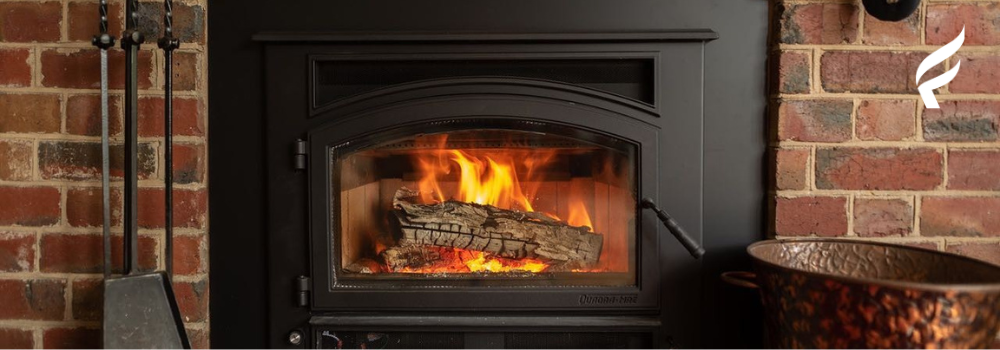What is a Fireplace Insert and How Does It Work?
A fireplace insert functions inside of an existing fireplace structure. Inserts offer a great way to get more out of your existing fireplace – with cleaner and better heat output, optimal functionality and even potential cost savings.
Traditional wood fireplaces are not heat-efficient – because a lot of the heat produced from them is lost up the chimney. “Traditional fireplaces suck the air your furnace or electric heat pump is putting out and pull it right out of your house,” says Tim Reed, hearth expert and retail team leader at Fireside Home Solutions in Portland, Oregon. Open fireplaces are also prone to cold drafts between the fire uses, making it harder to heat your home.
Fireplace inserts are a beautiful solution to preserve the beauty of your existing fireplace structure while allowing you to optimize certain aspects, including the fuel type that's right for you!
What Sets Fireplaces Inserts Apart?
While most fire lovers enjoy a fireplace's warmth, charm and ambiance, there could be a better solution: using an insert in an existing fireplace space.
With a fireplace insert, you can seal your fireplace and keep the air you paid to heat in your home with a cleaner burn. Want proof? When you use a fireplace insert, instead of seeing dark clouds of smoke emerge from your chimney, you see heat waves – that’s a good sign you’re breathing better air while also benefiting from a warmer home.
Another reason to consider a fireplace insert is cost savings. A furnace is used to heat every square inch of many homes – even empty, unused spaces. Reed suggests that zone heating is the way to go and it is catching on more and more across the country. It allows you to turn down your thermostat, then crank up your fireplace insert for a fraction of the cost of what it would be to rely solely on your furnace.
Ready to Transition Your Fireplace Insert?
If you're strongly considering updating your traditional wood-burning fireplace with a fireplace insert, keep these things in mind:
1. Fuel typeFuel type is a primary consideration for picking a fireplace insert. Here, we’ll walk through each option:
Pellet

If you’d like an insert that burns solid fuel, there are two options: pellet or wood (more on the latter later.) Pellet inserts warm your home similar to the heat of wood-burning stoves, with the convenience of an automated system. It’s a great green fuel source since the pellets are made from sawdust that would otherwise be discarded. And it’s easy to use. You toss the pellets in the hopper, set the thermostat, and it takes things from there. Beyond that, pellets are so easy to store (in 40-lb. bags) and burn (at 80% efficiency), that over one million U.S. homeowners have made the switch.
Browse Quadra-Fire’s full lineup of pellet fireplace inserts.
Wood

Getting a wood-burning insert. can give you up to an eight-hour burn, compared to perhaps two to two-and-a-half hours with a conventional wood burning fireplace. “Not only does it give a long burn time and use less firewood, it also burns nearly 20 times cleaner than a standard wood fireplace,” remarks Reed. Quadra-Fire’s Four-Point Burn System has four stages that combust all wood, exhaust gas, smoke and impurities in your firebox. What’s more, Automatic Combustion Control. gives you longer and more efficient burns.
Browse Quadra-Fire’s full lineup of wood fireplace inserts.
2. Aesthetic
Begin by thinking about the look you’d like for your fireplace insert. If you need inspiration, look to sources like HGTV, Pinterest and Houzz to help visualize the dream for your home. Reed says, “I guarantee that with all the product variety available through Quadra-Fire, we’ll be able to find a look for just about every home, from clean and modern to rustic and traditional.”
For gas inserts, you can choose from an array of finishes and styles to complete the look of your fireplace and complement your space. You can choose between a steel insert or one with a cast iron front for pellet or wood inserts. Reed says, “Steel is a more traditional stove look, and it’s awesome. The cast iron can be very ornate and has the advantage of retaining heat a bit longer than steel. No matter the choice, each option allows you to complement your home décor.”
3. Size
Get ahead by coming in with some basic dimensions. In particular, you should measure your current fireplace's front and back width and its overall height and depth. When you know the exact dimensions, representatives helping you can find an insert that is just the right size, gives you the perfect amount of warmth, and fits the unmistakable style of your room.

4. Installation Time
If you’ve made the decision to get an insert, plan on the installation taking at least half a day, depending on the specifics of your insert type and the space in which it’s being installed. “It’s most often a low-risk, low-mess project,” Reed says. For all types of inserts, we recommend an annual checkup.
5. Annual Maintenance for Fireplace Inserts
“It’s best to work with a hearth professional who will do an in-home preview and install it for you. There are too many unknowns to take the project on by yourself,” Reed suggests. Then, you’ll begin enjoying the benefits. Once people adopt zone heating, it becomes a lifestyle they really enjoy. You aren’t paying to heat the space you’re not in, and you can enjoy gathering everyone around a warm, cozy fire.
Where to Shop
Ready to shop around for the perfect fireplace insert? Look no further than Quadra-Fire. We’ve got options ranging from the Expedition II Wood Insert to the Trekker Series Pellet Insert (which offers a tax credit to incentivize the purchase even more). If these models don’t suit your fancy, drop in at a certified Quadra-Fire dealer near you to check out these and other models in person!


